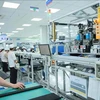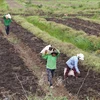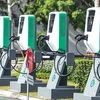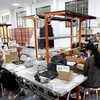Along with many action programmes such as the National Target Programme on Energy Saving and Efficiency, Environmental Industry Development Project until 2015 with a Vision Towards 2020, the Cleaner Production (CL) Strategy until 2020 was also promoted in industries, with a view to green and sustainable industrial development. Report by the Vietnam Economic News.
According to Deputy Minister of Industry and Trade Le Duong Quang, the ministry, as a state agency in charge of industrial and commercial management, in recent years has developed and implemented numerous programmes and projects to promote industrial production and trade to develop sustainability, such as the Environmental Industry Development Project until 2015 with a Vision Towards 2020 and Bio-fuel Development Project until 2015 with a Vision Towards 2020. The programmes and project have contributed significantly to the transformation of the production and changing consumption habits of industrialised products, reduction of waste into the environment while making the most use of natural resources, creating better working conditions for the workers while increasing productivity, improving the competitiveness of industrial products, and promoting green and sustainable industrial development.
It is estimated that there have been more than 1,200 businesses across the country applying cleaner production solutions. The ministry has organised nearly 200 CP training sessions and workshops attracting more than 11,000 participants, contributing to raising CP awareness for domestic businesses and related organisations. In particular, more than 20 provinces and cities nationwide have prepared CP action plans for implementing the CP strategy in industry and all departments of industry and trade are capable of guiding and counseling on the application of cleaner production in industry.
Many businesses have taken initiatives to apply CP solutions through pollution control at the source and take advantage of other business waste as raw materials. For example, to become an eco-industrial park or environmentally friendly industrial park, Bien Hoa 1 Industrial Park has focused on waste reduction at source, and reusing and recycling waste; waste exchange inside and outside the industrial park and end of pipe treatment of waste. Through a survey in 53 manufacturing companies in Bien Hoa 1 Industrial Park, 14 companies have applied processes to reuse waste products and waste materials from their production lines; five companies often exchanges waste with waste collectors outside the park; and one company has applied CP solutions.
According to Quang Nam province’s Department of Industry and Trade, some 90 percent of industrial production units and 95 percent of management units in the province have learnt about CP solutions. The province has incorporated a CP promotion program into the strategy of environmental protection and pollution control. CP activities have always been maintained after the CP in industry component ended in 2011. Through CP solutions, industrial enterprises in the province have reduced five percent on raw materials and 30 percent of emissions.
As Vietnam is gradually developing renewable energy projects, with limited use of new energy sources and applying solutions to energy efficiency and savings in the sectors of commerce, industry and services, the initial CP results have contributed significantly to its roadmap to the green and sustainable industrial development.
Data reported at a workshop held in Hanoi on September 18 by the Vietnam Environment Administration showed that the content of particulates around most industrial zones (IZs) exceeded the allowed limit (in some places it was found to be three or four times higher than the allowed limit). Pollution is caused mostly by dust, carbon dioxide (CO2), sulfur dioxide (SO2) and noise, leading to serious degradation of the environment and directly affecting socioeconomic development results as well as human health.
Solid waste is also a matter of concern. Statistics show that IZs in Vietnam discard an average of several ten thousand tonnes of solid waste each day or over three million tonnes each year. The index is growing along with increases in the fill-up ratio of IZs. It is forecasted that the total amount of solid waste from IZs would reach 6-7.5 million tonnes by 2015 and 9-13.5 million tonnes by 2020.
Environmental pollution caused by wastewater is even more serious. Currently, most IZs lack central wastewater treatment stations. The amount of wastewater from IZs in the Southeastern region accounts for 49 percent of the total amount of wastewater from all IZs nationwide, while only 66 percent of the IZs have central wastewater treatment stations. Many IZs have come into operation but still lack wastewater treatment systems. Some IZs already have wastewater treatment systems but have yet to put them into operation. In some IZs, the wastewater treatment system has been ineffectively operated or has degraded. It is estimated that about 70 percent of wastewater from IZs runs directly into the environment without any treatment.
Experts attributed this situation mostly to the limited public awareness about environmental protection and protecting the environment of IZs in particular. In their opinion, the community is yet to appreciate the important role of the environment as well as the sustainable relationship between production activities and the lives of workers in IZs as well as between the IZs and surrounding areas. Many IZs attract investment and build infrastructure without following the design of investment projects. They ignore building central wastewater treatment systems and their investment in water drainage facilities is inadequate.
Notably, the regulations on environmental protection in IZs are still lacking. There are no specific regulations regarding environmental pollution control in IZs. The regulation on environmental assessment of projects based in IZs has been slowly revised and lacks strict sanctions. Legal documents which are applied to monitor the treatment of wastewater in IZs remain unclear. Most environmental incidents happened due to the lack of seriousness by businesses in implementing environmental protection commitments. Many businesses have eluded environmental inspectors. The economic recession in recent years has been an obstacle to efforts by firms to invest in environmental protection. Environmental inspection activities have yet to meet practical demand.
The National Assembly Standing Committee held a meeting on September 19, 2013 to collect opinions on draft amendments to the Environmental Protection Law. The National Assembly’s Ethnic Council Chairman Ksor Phuoc said that to improve the situation, the state must apply a mechanism that encourages all people to take part in environmental protection activities. In his opinion, it is necessary to bring into play the role of the people, government officials at different levels and sociopolitical organizations in supervising the implementation of environmental protection policies and regulations in localities.-VNA
According to Deputy Minister of Industry and Trade Le Duong Quang, the ministry, as a state agency in charge of industrial and commercial management, in recent years has developed and implemented numerous programmes and projects to promote industrial production and trade to develop sustainability, such as the Environmental Industry Development Project until 2015 with a Vision Towards 2020 and Bio-fuel Development Project until 2015 with a Vision Towards 2020. The programmes and project have contributed significantly to the transformation of the production and changing consumption habits of industrialised products, reduction of waste into the environment while making the most use of natural resources, creating better working conditions for the workers while increasing productivity, improving the competitiveness of industrial products, and promoting green and sustainable industrial development.
It is estimated that there have been more than 1,200 businesses across the country applying cleaner production solutions. The ministry has organised nearly 200 CP training sessions and workshops attracting more than 11,000 participants, contributing to raising CP awareness for domestic businesses and related organisations. In particular, more than 20 provinces and cities nationwide have prepared CP action plans for implementing the CP strategy in industry and all departments of industry and trade are capable of guiding and counseling on the application of cleaner production in industry.
Many businesses have taken initiatives to apply CP solutions through pollution control at the source and take advantage of other business waste as raw materials. For example, to become an eco-industrial park or environmentally friendly industrial park, Bien Hoa 1 Industrial Park has focused on waste reduction at source, and reusing and recycling waste; waste exchange inside and outside the industrial park and end of pipe treatment of waste. Through a survey in 53 manufacturing companies in Bien Hoa 1 Industrial Park, 14 companies have applied processes to reuse waste products and waste materials from their production lines; five companies often exchanges waste with waste collectors outside the park; and one company has applied CP solutions.
According to Quang Nam province’s Department of Industry and Trade, some 90 percent of industrial production units and 95 percent of management units in the province have learnt about CP solutions. The province has incorporated a CP promotion program into the strategy of environmental protection and pollution control. CP activities have always been maintained after the CP in industry component ended in 2011. Through CP solutions, industrial enterprises in the province have reduced five percent on raw materials and 30 percent of emissions.
As Vietnam is gradually developing renewable energy projects, with limited use of new energy sources and applying solutions to energy efficiency and savings in the sectors of commerce, industry and services, the initial CP results have contributed significantly to its roadmap to the green and sustainable industrial development.
Data reported at a workshop held in Hanoi on September 18 by the Vietnam Environment Administration showed that the content of particulates around most industrial zones (IZs) exceeded the allowed limit (in some places it was found to be three or four times higher than the allowed limit). Pollution is caused mostly by dust, carbon dioxide (CO2), sulfur dioxide (SO2) and noise, leading to serious degradation of the environment and directly affecting socioeconomic development results as well as human health.
Solid waste is also a matter of concern. Statistics show that IZs in Vietnam discard an average of several ten thousand tonnes of solid waste each day or over three million tonnes each year. The index is growing along with increases in the fill-up ratio of IZs. It is forecasted that the total amount of solid waste from IZs would reach 6-7.5 million tonnes by 2015 and 9-13.5 million tonnes by 2020.
Environmental pollution caused by wastewater is even more serious. Currently, most IZs lack central wastewater treatment stations. The amount of wastewater from IZs in the Southeastern region accounts for 49 percent of the total amount of wastewater from all IZs nationwide, while only 66 percent of the IZs have central wastewater treatment stations. Many IZs have come into operation but still lack wastewater treatment systems. Some IZs already have wastewater treatment systems but have yet to put them into operation. In some IZs, the wastewater treatment system has been ineffectively operated or has degraded. It is estimated that about 70 percent of wastewater from IZs runs directly into the environment without any treatment.
Experts attributed this situation mostly to the limited public awareness about environmental protection and protecting the environment of IZs in particular. In their opinion, the community is yet to appreciate the important role of the environment as well as the sustainable relationship between production activities and the lives of workers in IZs as well as between the IZs and surrounding areas. Many IZs attract investment and build infrastructure without following the design of investment projects. They ignore building central wastewater treatment systems and their investment in water drainage facilities is inadequate.
Notably, the regulations on environmental protection in IZs are still lacking. There are no specific regulations regarding environmental pollution control in IZs. The regulation on environmental assessment of projects based in IZs has been slowly revised and lacks strict sanctions. Legal documents which are applied to monitor the treatment of wastewater in IZs remain unclear. Most environmental incidents happened due to the lack of seriousness by businesses in implementing environmental protection commitments. Many businesses have eluded environmental inspectors. The economic recession in recent years has been an obstacle to efforts by firms to invest in environmental protection. Environmental inspection activities have yet to meet practical demand.
The National Assembly Standing Committee held a meeting on September 19, 2013 to collect opinions on draft amendments to the Environmental Protection Law. The National Assembly’s Ethnic Council Chairman Ksor Phuoc said that to improve the situation, the state must apply a mechanism that encourages all people to take part in environmental protection activities. In his opinion, it is necessary to bring into play the role of the people, government officials at different levels and sociopolitical organizations in supervising the implementation of environmental protection policies and regulations in localities.-VNA



















